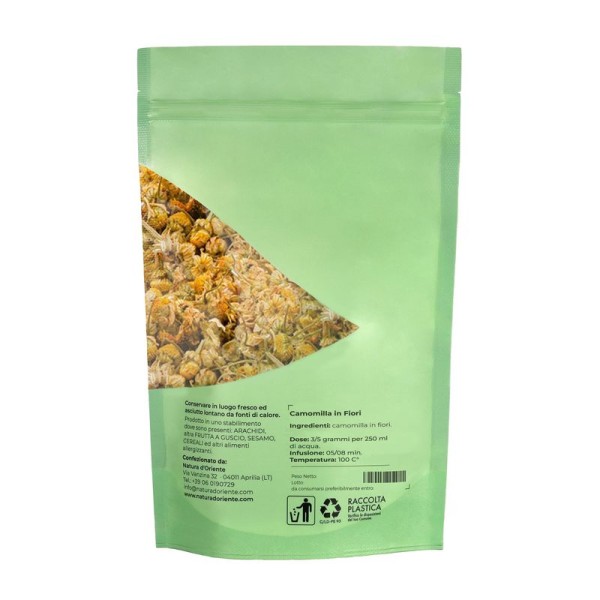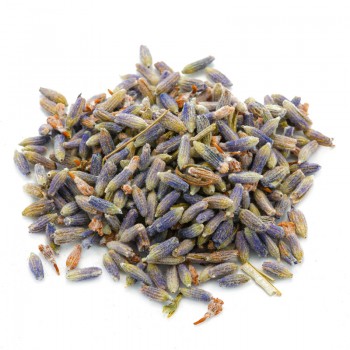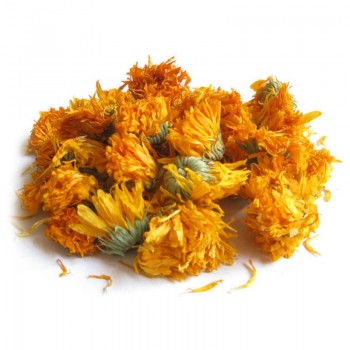Chamomile is certainly one of the best known natural remedies and used for relaxation and well-being of our body.
We know that there are different types of chamomile, but the most used remedies are the flowers of the common chamomile and Roman chamomile. They have very similar properties, beneficial for well-being and relaxation, even if this version of common chamomile is the one most used as a medicinal plant.
Chamomile: properties and benefits
Chamomile has been a plant that has been used for millennia for its excellent antispasmodic and natural calming properties.
To get the benefits, dried chamomile flowers are used to make an excellent tea.
In herbal culture it represents a nervine plant, which acts on the central nervous system. The infusion of flowers, in fact, is an excellent calming of the nerves and anxiety states and facilitates sleep, acting as a natural tranquilizer against stress and agitation.
The sedative effects may be due to the flavonoid apigenin, which works by binding to some receptors in our brain.
Chamomile flowers are used for infusions useful as carminatives, which help to counteract digestive disorders such as the accumulation of air in the stomach and intestines (aerophagia).
In addition, chamomile soothes the pains of colic resulting from aerophagia, and is often used in cases of stomach pain, stomach and intestinal pain.
They are the flavonoid apigenin and coumarin, which possess spasmolytic properties useful for such treatments.
This medicinal plant is an emmenagogue, that is, it facilitates the appearance or increases the menstrual flow, and is often used for female well-being as a stimulant of menstrual regularity, as well as calming menstrual pain . Consumption of constant chamomile tea can reduce the pain of cramps related to the monthly cycle.
The effectiveness of chamomile teas varies according to the concentration, but in any case it gives a good amount of flavonoids - antioxidant nutrients that play a significant role in the medicinal effects of chamomile.
Some recent studies have been focusing for some years on the beneficial properties of chamomile with respect to the concentration of sugar in the blood, thanks to the presence of substances such as quercetin, luteolin and esculetin.
Origins and History of cultivation
One of the most common herbs used for medicinal purposes for millennia is chamomile, mainly through the infusion and herbal extracts are prepared from dried flowers.
Originally from Western Europe, India and Asia as part of the daisy family (Asteraceae or Compositae), it has been applied in the past to treat many ailments.
It was also cultivated on the American continent, after the arrival of the Europeans, and today it is widespread almost all over the world.
Its name derives from the Greek khamai which means on the earth, and melon, with the meaning of apple.
Chamomile was revered as a sacred herb by the ancient Saxons, also referred to as the eyelash of Balder, the Norse god of light. The Egyptians used it to treat malaria, thanks to its dedication to the sun god, Ra.
It was prescribed for inflammation, muscle spasms, menstrual and gastrointestinal disorders; especially to treat insomnia.
Its anti-inflammatory properties were useful for treating hay fever, rheumatic pain and many ointments were used for hemorrhoids and wounds.
Medicinal ingredients were extracted from dried chamomile flowers using water and alcohol, and still today for its benefits the chamomile infusion is one of the most popular herbal teas in the world. < / p>
At least one million cups of chamomile are consumed every day, and both dried flowers for herbal tea and sachets with chamomile flower powder, pure or mixed, are available with other medicinal herbs.
The whole chamomile plant is also used to create herbal beers, and also for soothing lotions against neuralgia, toothache, earache, external swelling of the tissues or mucous membranes.
Chamomile in the phytotherapy tradition is also a vulnerary plant, that is, with healing and soothing properties. Chamomile flowers contain volatile oils, and substances useful to create anti-inflammatory ointments for the skin in case of eczema.
Plant and flowers
Matricaria chamomilla L., known as chamomile, is part of the Asteraceae, the botanical family of daisies.
At the level of officinal herb, it is present in two known varieties: German chamomile (Matricaria recutita, or Chamomilla recutita) and Roman chamomile (Chamaemelum nobile), with a similar appearance .
Give some disc or tubular flowers, with a sweet scent, that grow on the famous long stems and are similar to daisies. They bloom from May to September, are harvested and dried like flowers for chamomile tea.
The German chamomile or common, the one we propose for the infusion of flowers, is a resistant and self-sowing perennial.
Releases a pleasant apple aroma , and was used in the Middle Ages to perfume floors and passageways in the house - also to deter insects.
For its scent, the Spaniards call it manzanilla grass (small apple).
Nutritional values of Chamomile
In this plant there are several bio-active constituents such as terpenoids and flavonoids.
The main components are sesquiterpene lactones, chamazulene, farnesene, hydroxycoumarins. Among the coumarins, there are elements of herniarin and umbelliferone.
Other important constituents of flowers include phenolic compounds, mainly flavonoids such as apigenin, quercetin, luteolin, patuletin.
In lower concentrations, we also find other substances such as mineral salts, vitamins (A, B), fatty acids and organic acids.
How to consume Chamomile in flowers as a herbal tea and in the kitchen
For a good infusion, it is advisable to use for a cup (250 ml), about 3-5 grams of Chamomile flowers with water at 100 ° C.
Leave to infuse for 5 to 7 minutes, before drinking the herbal tea.
Add honey or sugar if desired.
Chamomile: side effects and contraindications
Although it is a food safe plant, it is possible that a low percentage of people are sensitive to chamomile; especially if you have already had allergic or skin reactions with ragweed, chrysanthemums or other members of the Compositae family.
It is important to take chamomile in doses that are not excessive, to avoid interactions with other drugs.
It is always safe to start with a low dose and slowly move up to higher doses.











 No reward points for this product.
No reward points for this product.





